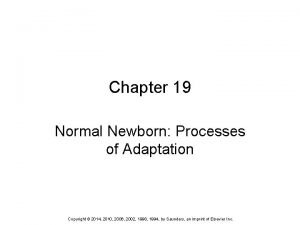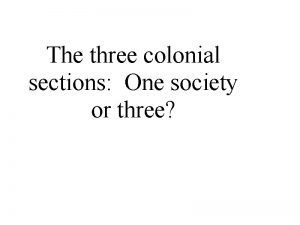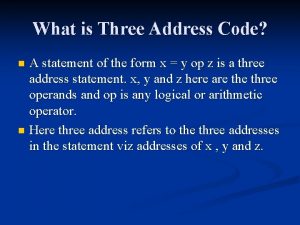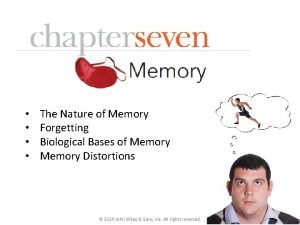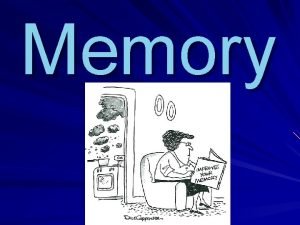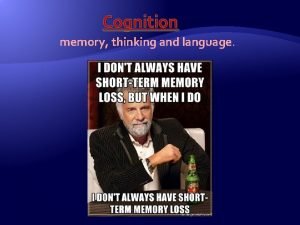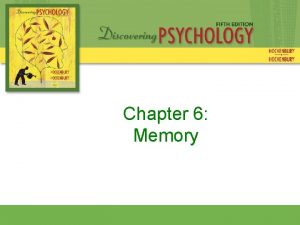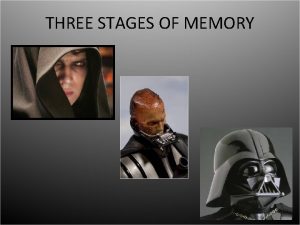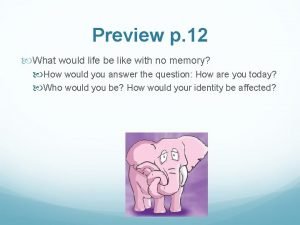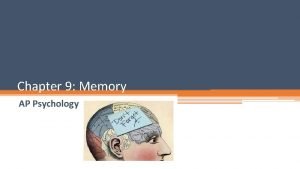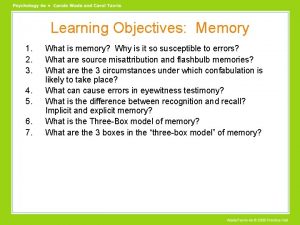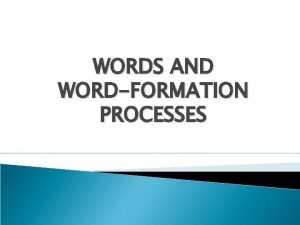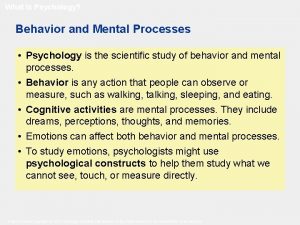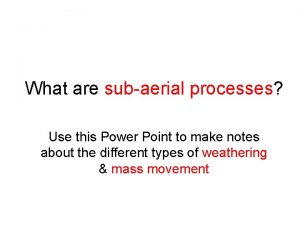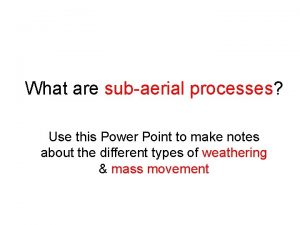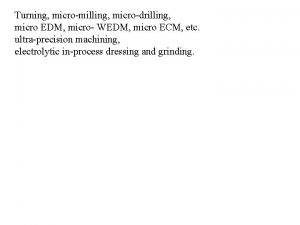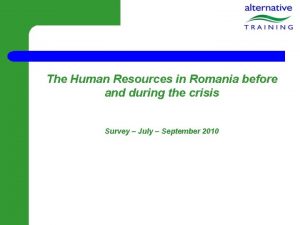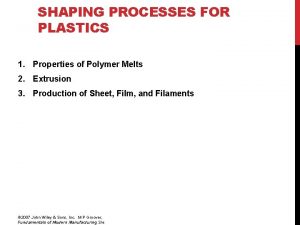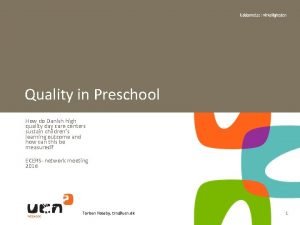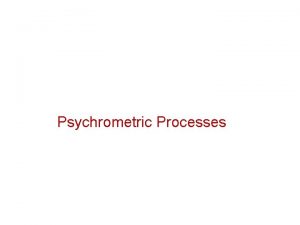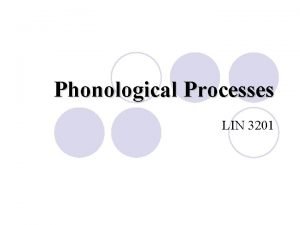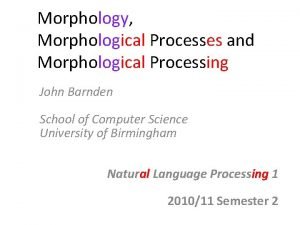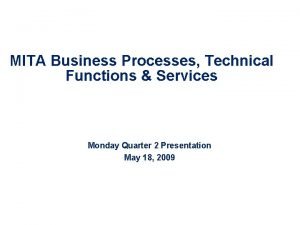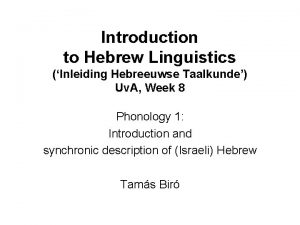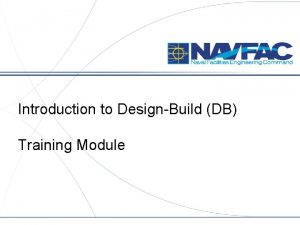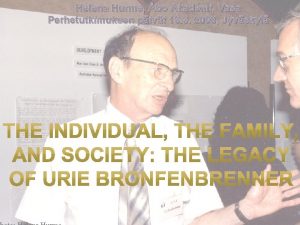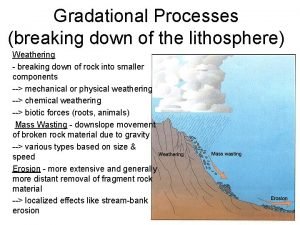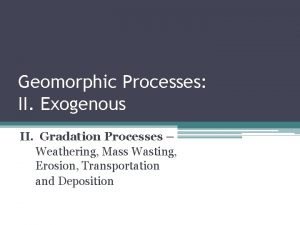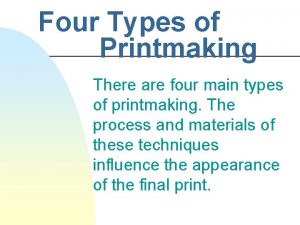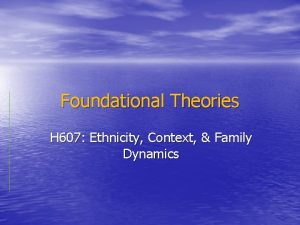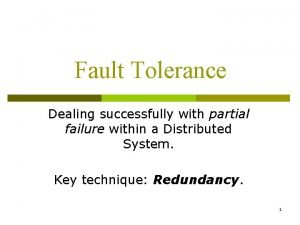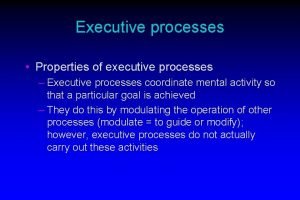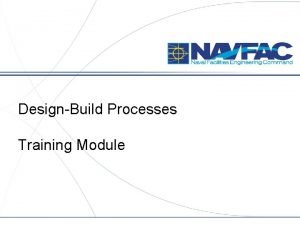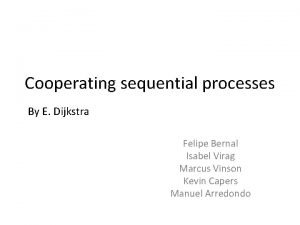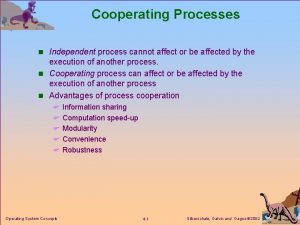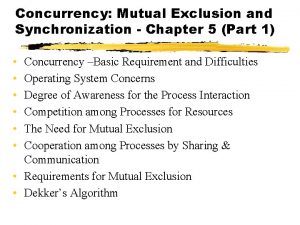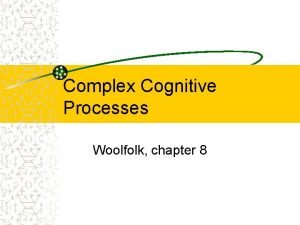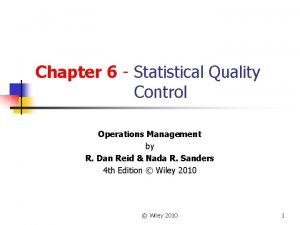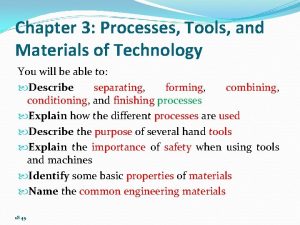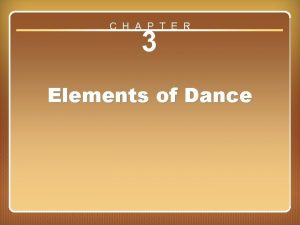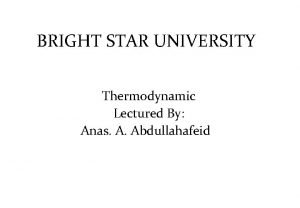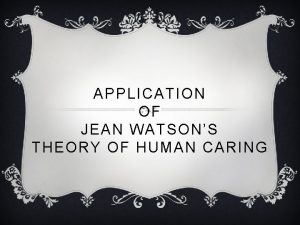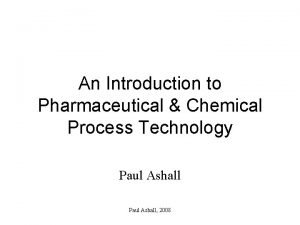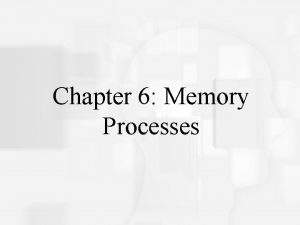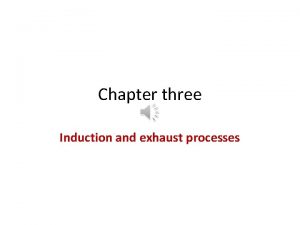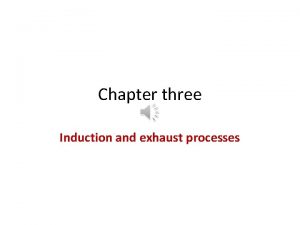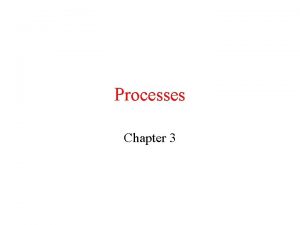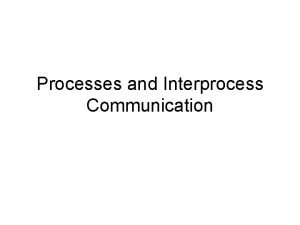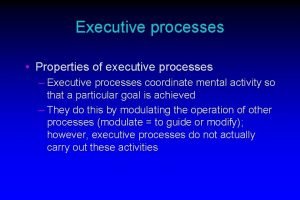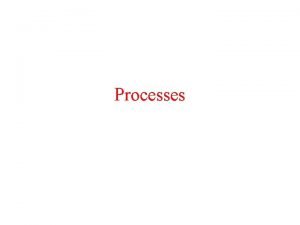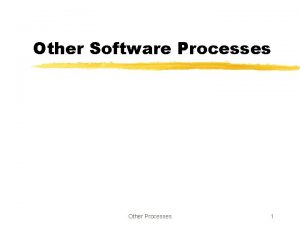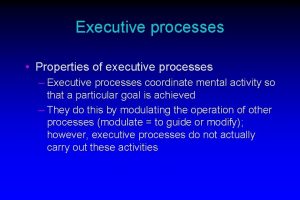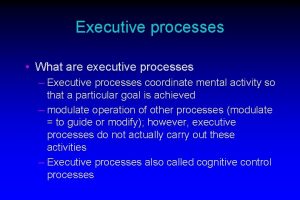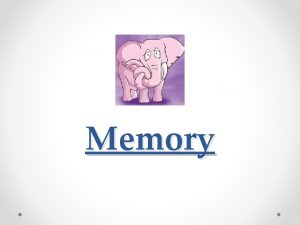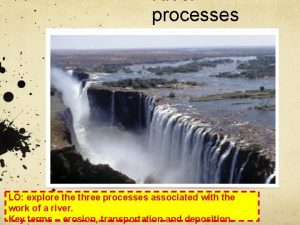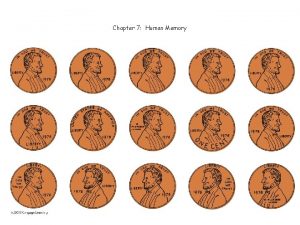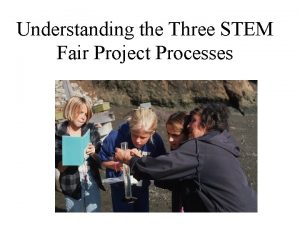Memory Chapter 6 Three Processes of Memory Memory
























































































- Slides: 88

Memory Chapter 6

Three Processes of Memory �Memory – an active system that receives information from the senses, puts that information into a usable form, and organizes it as it stores it away, and then retrieves the information from storage �Although there are several different models of how memory works, all of them involve the same 3 processes �Getting the information into the memory system �Storing the information �Retrieving the information

Encoding: Putting Information In � The first process in the memory system is to get sensory information (ex. Sight, sound, etc. ) into a form that the brain can use � Encoding – the set of mental operations that people perform on sensory information to convert that information into a form that is usable in the brain’s storage systems �Ex. When people hear a sound, their ears turn the vibrations in the air into neural messages from the auditory nerve (transduction), which make it possible for the brain to interpret that sound � Encoding is not limited to turning sensory information into signals for the brain �It is accomplished differently in each of the three different storage systems of memory �In one system, encoding may involve rehearsing information over and over to keep it in memory, whereas in another system, encoding involves elaborating on the meaning of the information

Storage: Keeping Information In �The next step in memory is to hold on to the information for some period of time �Storage – holding onto information for some period of time �The period of time will actually be of different lengths, depending on the system of memory being used �Ex. In one system of memory, people hold on to information just long enough to work with it, about 20 seconds or so; but in another system, people hold on to information more or less permanently

Retrieval: Getting Information Out �The biggest problem many people have is retrieval �Retrieval – getting information that is in storage into a form that can be used �Ex. You have taken an essay exam, later after the test is over, you remember several other things you could have said

Models of Memory: Information. Processing �Many researchers feel the information-processing model of memory is the most comprehensive and has been the most influential �Assumes the processing of information for memory storage is similar to the way a computer processes memory in a series of three stages �Focuses on the way information is handled, or processed, through three different systems (sensory memory, short-term memory, long-term memory) �The processes of encoding, storage, and retrieval are seen as part of this model

Models of Memory: Parallel Distributed Processing (PDP) Model � It is common to refer to the three memory systems of the information-processing model as stages, BUT that implies a sequence of events � While many aspects of memory may follow a series of steps or stages, there are those who see memory as a simultaneous process, with the creation and storage of memories taking place across a series of mental networks “stretched” across the brain � Parallel distributed processing (PDP) model – memory processes are proposed to take place at the same time over a large network of neural connections �Derived from work in the development of artificial intelligence (AI) �In the AI world, PDP is related to connectionism (the use of artificial neural networks to explain the mental abilities of humans)

Models of Memory: Levels-of. Processing Model � The information-processing model assumes that the length of time that a memory will be remembered depends on the stage of memory in which it is stored � Levels-of-processing model – assumes information that is more “deeply processed, ” or processed according to its meaning rather than just the sound or physical characteristics of the word or words, will be remembered more efficiently and for a longer period of time � Ex. If the word BALL is flashed on a screen and people are asked to report whether the word was in capital letters or lowercase, the word itself does not have to be processed very much – only its visual characteristics need to enter into conscious attention � But, if those people were asked to use that word in a sentence, they would have to think about what a ball is and how it can be used � They would have to process its meaning, which requires more mental effort than processing just the word’s “looks” � Numerous experiments have shown that thinking about the meaning of something is a deeper level of processing and results in longer retention of the word

Which Model Explains Which Aspects of Memory � All of three models can be used to explain some, if not all, research findings about memory � Information-processing model �Provides a “big picture” view of how the various memory systems relate to each other – how the “memory machine” works � PDP model �Is less about the mechanics of memory and more about the connections and timing of the memory process � Levels-of-processing model �The depth to which information is processed addresses the strength of those parallel connections within each of the three memory systems, with strength and duration of the memory increasing as the level of processing deepens � Although the information-processing model takes center stage for explaining memory for now, it is important to remember the concepts of the levels at which information is processed and the way that those processes may take place

Information-Processing Model: 3 Memory Systems �Information-processing theory bases its model for human thought on the way a computer functions �Data are encoded in a manner that the computer can understand use �The computer stores that information on a disk, hard drive, or memory stick �Then, the data are retrieved out of storage as needed �Information-processing theorists were the first to propose that there are three stages or types of memory systems �Sensory memory, short-term memory, and long- term memory

Sensory Memory � Sensory memory – the first stage of memory, the point at which information enters the nervous system through the sensory systems � Information is encoded into sensory memory as neural messages in the nervous system � As long as those neural messages are traveling through the system, it can be said that people have a “memory” for that information that can be accessed if needed � Example: the “double take” � Imagine you are driving down the street, looking at the people and cars on either side of your car. All of a sudden you think “Wait a minute, was that guy not wearing pants? !” then you look back to check. � How did you know to look back? Your eyes had already moved past the possible pants-less guy, but some part of your brain must have just processed what you saw. � This can only be explained by the presence, however brief, of a memory for what you saw � There are 2 kinds of sensory memory that have been studied extensively

Iconic Sensory Memory: Capacity � Iconic sensory memory – visual sensory memory, lasting only a fraction of a second � George Sperling (1960) � Partial report method: presented subjects with a grid of letters and sounded either a high, medium, or low tone immediately after the grid of letters was taken away, which signaled which row subjects were to report � The tone was sounded after the grid was taken away to that subjects couldn’t just memorize one row of letters Rows of Letters Tone Signaling Which Row to Report LHTY High tone EPNR Medium tone SBAX Low tone � Found that subjects could accurately report any of the three rows, meaning that the entire grid was in iconic memory and available to the subjects � Thus, the capacity of iconic memory is everything that can be seen at one time

Iconic Sensory Memory: Duration � Sperling also found that if he delayed the tone for 1 second, subjects could no longer accurately report letters from the grid �The iconic information had completely faded out of memory in that brief time � In real life, information that has just entered iconic memory will be pushed out very quickly by new information, a process called masking �Research suggests that after only a quarter of a second, old information is replaced by new information � Eidetic imagery – the ability to access a visual memory for 30 seconds or more �Very rare condition, often called photographic memory, cause is unknown �People with eidetic imagery ability might be able to look quickly at a page in a book, then by focusing on blank wall or piece of paper, “read” the words from the images that still lingers in their sensory memory �More common in children and tends to diminish by adolescence or young adulthood

Iconic Memory: Function �Iconic memory actually serves a very important function in the visual system �Remember that the eyes make tiny movements called saccades that keep vision from adapting to a constant visual stimulus, so that what is stared at steadily doesn’t slowly disappear �Iconic memory helps the visual system to view surroundings as continuous and stable in spite of the saccadic movements �It also allows enough time for the brain stem to decide if the information is important enough to be brought into consciousness �Like the possibly pants-less guy from the example earlier

Echoic Sensory Memory � Echoic memory – the brief memory of something a person has just heard � Ex. The “What? ” phenomenon � When you are reading, watching TV, or concentrating on something and someone walks up to you and asks you if your ready for dinner. You sit there for a second or 2, and then say “What? Oh … yes I’m ready to eat now” Dude, you ready to eat? what? !? . . . Oh, yea I’m ready � You didn’t really process the statement from the other person as he or she said it, you heard it, but your brain didn’t interpret it immediately. � Instead, it took several seconds for you to realize that � 1) something was said � 2) it may have been important � 3) you’d better try and remember what it was � If you realize all this within about 4 seconds (the duration of echoic memory), you will likely be able to “hear” an echo of the statement in your head � Like a kind of “instant replay”

Echoic Sensory Memory �Capacity is limited to what can be heard at any one moment and is smaller than the capacity of iconic memory, although it lasts longer (about 2 -4 seconds) �Useful in conversations, allows a person to remember what someone said long enough to recognize the meaning of a phrase �And like iconic memory, it allows people to hold on to incoming information long enough for the lower brain centers to determine whether or not processing by higher brain centers is needed

Short-Term and Working Memory � Short-term memory (STM) – the memory system in which information is held for brief periods of time while being used � Like a sort of “desk” where people hold and work on information for a short time � If an incoming sensory message is important enough to enter consciousness, that message will move from sensory memory to short-term memory � This is accomplished through the process of selective attention – the ability to focus on only one stimulus from among all sensory input � Dr. Donald E. Broadbent’s original filter theory of memory suggests a kind of “bottleneck” occurs between sensory memory and STM � Only a stimulus that is “important” enough will be passed on to be analyzed for meaning in STM � What is important is determined by a kind of “pre-analysis” in attention centers in the brain stem � Other stimuli are filtered out and will not reach consciousness � Also, when a person is thinking actively about information, that information is said to be conscious and in STM

Short-Term and Working Memory � But, it is difficult to use this original selective attention filter theory to explain the “cocktail-party effect” � Ex. When you’re at a party somewhere and there’s a lot of noise and several conversations going on in the background but you are still able to notice when someone says. Doug your name Did someone just say my name? � In this situation, the higher areas of the brain that are involved in selective attention had to be working – even though you were not consciously aware of it � Then, when that important bit of information (your name) “appeared, ” those areas somehow filtered the information into your conscious awareness – in spite of the fact that you weren’t paying conscious attention to the background noise � In the original theory, selective attention only operates after you are consciously aware of a stimulus

Short-Term and Working Memory � A newer theory, proposed by Dr. Anne M. Treisman, suggests that selective attention operates in a two-stage filtering process � 1 st stage: incoming stimuli in sensory memory are filtered on the basis of simply physical characteristics � This is similar to Broadbent’s original idea � However, the filtering in this case is not an “all-or-nothing” event as in Broadbent’s theory, rather it is a lessening or decrease (attenuation) of the signal strength of those unattended sensory stimuli when compared to attended stimuli � In other words, we lessen the signal strength of stimuli that are not important and not attended to � 2 nd stage: involves the processing of only the stimuli that meet a certain threshold of importance � Attenuated stimuli are present at this 2 nd stage so something as subjectively important as one’s own name may be able to be “plucked” out of the attenuated incoming stimuli �Ex. Selective attention is still working even when we’re asleep. This is why when a mother is asleep she can be awakened by her baby’s cries but sleep through the noise of the nightly train passing by (the noise of the train is unimportant and has been attenuated while the baby’s cries are important)

Short-Term and Working Memory � What happens when information does pass through the selective attention filter and into STM? � STM tends to be encoded primarily in auditory (sound) form �That means that people tend to “talk” to themselves inside their heads � Although some images are stored in STM in a kind of visual “sketchpad, ” auditory storage accounts for much of STM encoding � Research in which participants were asked to recall numbers and letters showed that errors were nearly always made with numbers or letters that sounded similar (T-3) than errors with those that looked similar (l 1)

Short-Term and Working Memory � Some memory theorists use the term working memory as another way of referring to STM �This usage is not entirely correct: STM has traditionally been thought of as a thing or a place into which information is put � Working memory is an active system that processes the information in STM and is thought to consist of 3 interrelated systems �The central executive (“CEO” or “Boss”): controls and coordinates �The visual “sketchpad”: for visual information �A kind of auditory “recorder”: for auditory information

Short-Term and Working Memory �The central executive interprets visual and auditory information and the visual and auditory information is itself stored in STM �Ex. When someone is reading a book �The sketchpad will contain images of the people and events of the particular passage being read �The recorder “plays” the dialogue in the person’s head �The central executive helps interpret the information from both systems and pulls it all together �So in a sense, then, STM can be seen as being a part of the working memory system

Short-Term and Working Memory �For instance, if you see someone familiar at the mall �You pull that person’s name from your more permanent memory and visualize that name along with the memory of the last time you saw the person, almost like you’re viewing it on a screen in your head �At the same time, you will hear the name in your head �The central executive pulls these different types of information together and you are able to successfully greet the person �Where you see and hear this information is in

STM Capacity: The Magic Number 7 � George Miller (1956): reviewed research on memory, including studies using a memory test called the digit-span test � A series of number is read to subjects, then, subjects are asked to recall the numbers in order � Each series of numbers gets longer and longer, until subjects cannot recall any of the numbers in order � Most everyone gets past the first 2 sequences of numbers � But some people will make mistakes on the 6 digit span, about half will make mistakes on the 7 digit span, and very few people will be able to get past the 9 digit span without making any mistakes � This lead Miller to conclude that the capacity of STM is about seven items or pieces of information � He called this the magic number 7, plus or minus 2 items (from 5 -9 bits of information) � Current research suggests younger adults can hold 3 -5 items of information at a time if a memory strategy is not being used � When the information is in the form of longer, similar-sounding words or unfamiliar words, that capacity reduces until it is only about 4 items

STM Capacity: Chunking �Chunking is a way to sort of “fool” STM memory into holding more information than usual �It is a process of recoding or reorganizing information �If the bits of information are combined into meaningful units, or chunks, more information can be held in STM �Ex. Remembering the digit span: 4, 8, 3, 9, 4, 3, 7, 1, 6, 2 �Would be easier if you grouped the numbers together into chunks: 483 -943 -7162 �Instead of 10 separate bits of information, there would only be 3 “chunks” that read like a phone

“Short”-Term Memory: How Long Does it Last? �Research shows that STM lasts from about 12 -30 seconds without rehearsal �After that, the memory seems to rapidly “decay” or disappear �The findings of one recent study with mice suggest that in order to form new memories, old memories must be “erased” by the formation of newly formed neurons �The hippocampus only has so much storage room �Many of the memories formed there will be transferred to more permanent storage in other areas of the brain �But, some memories, without rehearsal, will decay as new neurons (and newer memories) are added to the already existing neural circuits

STM: Maintenance Rehearsal � Maintenance rehearsal – practice of saying some information to be remembered over and over in one’s head in order to maintain it in STM � Ex. Like repeating a phone number over and over again just long enough for you to dial it � A person is simply continuing to pay attention to the information to be held in memory, and since attention is how that information got into STM in the 1 st place, it works quite well � Information will stay in STM until rehearsal stops, then the memory will rapidly decay and is forgotten � If anything interferes with maintenance rehearsal, memories are also likely to be lost � Ex. If you are trying to count a stack of dollar bills by reciting each number out loud while counting, and someone asks you what time it is, you will probably forget what the last number was and have to start all over again (so annoying) � Interference in STM can also happen if the amount of information to be held exceeds capacity (5 -9 bit of information) � This is why it’s possible to remember the 1 st few names of people you meet at a party, but as more names are added, they displace the older names � FYI: a better way to remember people’s names is to associate the name with something about the person’s appearance, this may help move the name from STM into more permanent storage

Long-Term Memory � Long-term memory (LTM) – the system of memory into which all the information is placed to be kept more or less permanently � The capacity of LTM seems to be unlimited for all practical purposes �Think about it, would there ever really come a time when you couldn’t fit one more piece of information into your head? � As for duration of LTM, there is a relatively permanent physical change in the brain itself when a memory is formed �That means that many of the memories people have stored away for a long time (even ones from childhood) may still be there �BUT, that doesn’t mean that people can always retrieve those memories, they may be available but not accessible, meaning they are still there, but for various reasons people cannot “get to” them � Ex. Its like knowing that there is a certain item on the back of the top shelf of the kitchen but having no ladder to reach it, the item is there (available) but you cant get to it (accessible)

Long-Term Memory � Information that is rehearsed long enough may actually find its way into LTM � Most people tend to learn poems and the multiplication tables by maintenance rehearsal, also known as rote learning � Rote is like “rotating” the information in your head, saying it over and over again � But maintenance rehearsal is not the most efficient way of putting information into LTM, because to get the information back out, you have to remember it almost exactly as it went in � Ex. Try this: what is the 15 th letter of the alphabet? � Did you have to recite or sing the alphabet song to get to that letter? Bet you did. � Although, many long-term memories are encoded as images, sounds, smells, or tastes, in general, LTM is encoded in meaningful form � A kind of mental storehouse of the meanings of words, concepts, and all the events that people want to keep in mind � Even the images, sounds, smells, and tastes involved in these events have some sort of meaning attached to them that gives them enough importance to be stored long term � If STM can be thought of as a working “surface” or desk, then LTM can be thought of as a huge series of filing cabinets behind the desk � Files are stored in an organized fashion, according to meaning � Files have to be placed in the cabinets in a certain organized fashion to be useful

LTM: Elaborative Rehearsal � Elaborative rehearsal – a method of transferring information from STM to LTM by making that information meaningful in some way � The easiest way to do this is to connect new information with something that is already well known �Ex. The French work maison means “house. ” � A person could try to memorize that (using maintenance rehearsal)by saying over and over “Maison means house. ” � But, it would be much easier and more efficient if that person simply thought, “Maison sounds like mason, and masons build houses. ” That makes the meaning of the word tie in with something the person already knows (masons who lay bricks to build houses) � The levels-of-processing approach discussed earlier proposes that information that is more “deeply processed, ” or processed according to meaning will be remembered more efficiently and for a longer period of time �This is true, elaborative rehearsal is a deeper kind of processing than maintenance rehearsal and also leads to better long-term storage

Types of Long-Term Information � Long-term memories include general facts and knowledge, personal facts, and even skills that can be performed � Procedural (nondeclarative) memory is memory for skills �Because it usually involves a series of steps or procedures �Ex. How to make a sandwich � Declarative memory is memory for facts �Because facts are things that are known and can be declared (stated outright) �Ex. Raleigh is the capital of North Carolina

Procedural (Nondeclarative) LTM �Type of long-term memory including emotional associations, memory for skills, procedures, habits, and conditioned responses �These memories are not conscious but are implied to exist because they affect conscious behavior �Ex. Tying shoes or riding a bicycle �There is evidence that different areas of the brain are responsible for procedural memories and declarative memories �The amygdala is the most probably location for emotional associations, such as fear �The cerebellum in the hindbrain is responsible for storage of memories of conditioned responses, skills and habits

Procedural (Nondeclarative) LTM � Evidence that separate areas of the brain control memory comes from studies of people with damage to the hippocampus � This damage causes anterograde amnesia – the loss of memory from the point of the injury or trauma forward, or the inability to form new long-term declarative memories � In one study, patients with this disorder were taught how to solve a particular puzzle � Patients were able to learn the sequence of moves necessary to solve the puzzle � But, when brought back into the testing room at a later time, they could not remember ever having seen the puzzle (or the examiner) before � Each trial was like the first one ever for these patients, as they were unable to store the long-term memory of having been in the room or having previously met the examiner � Yet, they were able to solve the puzzle even while claiming that they had never seen it before � Their procedural memories for how to solve the puzzle were evidently formed and stored in a part of the brain separate from the part controlling the memories they could no longer form

Procedural (Nondeclarative) LTM � The patients in the previous study had the kind of memory problems that people with Alzheimer’s disease have �Yet even people with Alzheimer’s disease do not forget how to walk, talk, fasten clothing, or even shoes (although they do lose motor ability because the brain eventually fails to send the proper signals) �These are all procedural, nondeclarative memories �They may not be able to tell someone that they know how to do these things, but they can still do them � Alzheimer’s disease affects the hippocampus and the frontal cortex (involved in decision making and planning) and eventually affects other areas of the brain after it has progressed nearly to the end � In fact, it would be rare to find someone who has lost procedural memory �Literally, these are the kind of memories people “never forget”

Procedural (Nondeclarative) LTM � Procedural memory is similar to the concept of implicit memory – memory that is not easily brought into conscious awareness �Because memories for these skills, habits, and learned reflexes are also not easily brought into conscious awareness �Ex. The fact that people have the knowledge of how to tie their shoes is implied by the fact that they can actually tie them � Such knowledge is in people’s memories because they use this information, but they are often not consciously aware of this knowledge � Although procedural memories are very often implicit, not all implicit memories are necessarily procedural �A memory from one’s early childhood of being frightened by a dog may not be a conscious memory in later childhood but may still be the cause of that older child’s fear of dogs �Conscious memories for events in childhood, on the other hand, are usually considered to be a different kind of long-term memory called declarative memory

Declarative LTM �Declarative memory – type of LTM containing information that is conscious and known �This type of memory is about all the things that people know �Including general facts such as the names of the planets in the solar system, that adding 2 and 2 makes 4, and that a noun is the name of a person, place, or thing �Also includes what people know about the things that have happened to them personally like what you ate for breakfast this morning and what you saw on your drive to class �There are 2 types of declarative long-term

Declarative LTM: Semantic � Semantic memory – type of declarative memory containing general knowledge, such as knowledge of language and information learned in formal education � This is the general knowledge that anyone has the ability to know � Most of this information is what is learned in school or by reading � Includes the awareness of the meanings of words, concepts, and terms as well as names of objects, math skills, and so on �Type of knowledge used on games shows like Jeopardy � Semantic memories, like procedural memories, are relatively permanent �But it is possible to “lose the way” to this kind of memory

Declarative LTM: Episodic � Episodic memory – type of declarative memory containing personal information not readily available to others, such as daily activities and events � Includes memory of daily life and personal history, like a kind of autobiographical memory � Ex. Certain birthdays or anniversaries that were particularly special, and childhood events � Unlike procedural and semantic LTM, episodic memories tend to be updated and revised more or less constantly � Ex. You can probably remember what you had for breakfast today, but what you had for breakfast 2 years ago on this date is most likely a mystery � Episodic memories that are especially meaningful, such as the memory of the first day of school or your first date, are more likely to be kept in LTM � Although these memories may not be as exact as people sometimes think they are � The updating process is a kind of survival mechanism, because although semantic and procedural memories are useful and necessary on an ongoing basis, no one really needs to remember every little detail of every day

Declarative LTM: Episodic & Semantic � Episodic and semantic memories are examples of declarative or explicit memory – memory that is consciously known �Explicit memories are easily made conscious and brought from long-term storage into short-term memory � The knowledge of semantic memories such as word meanings and episodic memories such as what you ate for breakfast can be brought out of the “filing cabinet” and placed on the “desk” where that knowledge becomes explicit, or obvious � The difference between implicit memories (like how to ride a bike) and explicit memories (like the names of all the planets) is that it is impossible or extremely difficult to bring implicit memories into consciousness �Explicit memories can be forgotten but always have the potential to be made conscious � Ex. When someone reminds you what you had for breakfast the day before, you will remember and realize that you had that information all along

LTM Procedural Memory Declarative memory (explicit) Episodic memory Events experienced by a person (implicit) Motor skills, habits, classically conditioned reflexes Semantic memory General facts and knowledge

LTM Organization � LTM has to be fairly well organized for retrieval to be so quick � Research suggests that LTM is organized in terms of related meanings and concepts � In one study (Collins & Quillian, 1969) subjects had to respond “true” or “false” as quickly as possible to sentences such as “a canary is a bird” and “a canary is an animal” �Found that responses to sentences such as “canary is an animal” took longer than responses to sentences such as “a canary is a bird” � Why? Because information exists in a kind of network, with nodes (focal points) of related information linked to each other in a kind of hierarchy

�To verify the statement “a canary is a bird” requires moving to only one node �But, “a canary is an animal” would require moving through two nodes and, therefore, takes longer

LTM Organization �The results of this study led the researchers to develop the semantic network model – assumes information is stored in the brain in a connected fashion, with concepts that are related stored physically closer to each other than concepts that are not highly related

LTM Organization � The parallel distributed processing model can be used to explain how rapidly the different points on the networks can be accessed � Although the access of nodes within a particular category (ex. Birds) may take place in a serial fashion, access across the entire network may take place in a parallel fashion � Allowing several different concepts to be targeted at the same time � Ex. You might be able to think about birds, cats, and trees simultaneously � Maybe, the best way to think of how information is organized in LTM is to think about the internet � A person might go on one website and from that site link to many other related sites � Each related site has its own specific information but is also linked to many other related sites � And you can have more than one site open at the same time � This may be very similar to the way in which the mind organizes the information stored in LTM

Retrieval of Long-Term Memories: Retrieval Cues � Most people’s problems with getting information stored in LTM back out again has to do with how the information was stored � Retrieval cue – a stimulus for remembering � The reason that maintenance rehearsal is not a very good way to get information into LTM is that saying something over and over gives only one kind of retrieval cue �The sound of the word or phrase � When people try to remember a piece of information by thinking of what it means and how it fits in with what they already know, they are giving themselves cues for meaning in addition to sound �The more cues stored with a piece of information, the easier the retrieval of that information will be

Encoding Specificity and State. Dependent Learning: Context & Mood � Although most people assume that cues for retrieval would have to be related to the information to be remembered, almost anything can become a cue � Encoding specificity – the tendency for memory of information to be improved if related information (such as surroundings or physiological state) that is available when the memory is first formed is also available when the memory is being retrieved �Ex. The best place to take a final exam is in the same room in which the class was held, because this was the environment where the information was encoded and will facilitate better retrieval of that information �Ex. Its very common to walk into a room and know that there was something in the room you wanted, but in order to remember it, you have to go back to the room you started in to use your surroundings as a cue for remembering what it is

Encoding Specificity and State. Dependent Learning: Context & Mood �In one study, students who were learning to scuba dive in a pool were asked to learn a word list when they were either out of the pool or in the pool under the water �Words that were learned while out of the pool were remembered significantly better when the subjects were out of the pool �Words that were learned underwater were more easily retrieved if the subjects were underwater while trying to remember

Encoding Specificity and State. Dependent Learning: Context & Mood � Physical surroundings at the time of encoding are not the only kinds of cues that can help retrieval � In state-dependent learning, memories formed during a particular physiological or psychological state will be easier to remember while in a similar state �Ex. When you are fighting with someone, it’s much easier to remember all the bad things that person has done than to remember the good times � In one study, researchers had subjects try to remember words that they had read while listening to music �Subjects read one list of words while listening to sad music (influencing their mood to be sad) and another list of words while listening to happy music �When it came time to recall the lists, researchers again manipulated the mood of the subjects �The words that were read while subjects were in a happy mood were remembered better if the manipulated mood was also happy, but far less well if the mood was sad (the reverse was also true)

Difference Between Recall and Recognition � 2 kinds of retrieval of memories �Recall – memories are retrieved with few or no external cues �Like fill in the blank or essay tests �Recognition – the ability to match a piece of information or a stimulus to a stored image or fact �Like multiple choice tests �This is why multiple choice tests are easier

Recall: Retrieval Failure �When ever people find themselves struggling for an answer, recall has failed (at least temporarily) �Tip of the tongue (TOT) phenomenon �Sometimes the answer to a question seems so close to the surface of conscious thought that if feels like the word is on “the tip of the tongue” �People may be able to say how long the word or name is, or even the first letter, but the cannot retrieve the sound or actual spelling of the word to allow it to be pulled into the auditory “recorded” part of STM so that it can be fully retrieved �Ex. http: //www. youtube. com/watch? v=G 4 ev-Bt. PMM 8

Recall: Retrieval Failure �How to over come TOT: The best solution is to forget about it �When you “forget about it, ” the brain apparently continues to work on retrieval �Sometime later (maybe when you run across a similarsounding word), the word or name will just “pop out. ”

Recall: The Serial Position Effect �Serial position effect – tendency of information at the beginning and end of a body of information to be remembered more accurately than information in the middle of the body of information �Demonstration: you instruct people to listen to and try to remember words that are read to them that are spaced about 4 or 5 seconds apart �People will typically use maintenance rehearsal by repeating each word in their heads �When they are asked to write as many words as they can remember, the frequency of recall will nearly always look like this. .

80 70 Primacy effect 60 Recency effect 50 40 % correct 30 20 10 0 1 2 3 4 5 6 7 8 9 10 11 12 13 Position in list

Serial Position Effect � Primacy effect – tendency to remember information at the beginning of a body of information better than the information that follows �Due to the fact that the 1 st few words, when the listener has nothing already in STM to interfere with their rehearsal, will receive far more rehearsal time than the words in the middle, which are constantly being replaced by the next word on the list �In fact, the 1 st words may actually move into LTM if they are rehearsed long enough � Recency effect – tendency to remember information at the end of a body of information better than the information at the beginning of it �This is attributed to the fact that the last word or two was just heard and is still in STM for easy retrieval � The serial position effect works with many different kinds of information �Ex. Business schools usually teach their students that they should try not to be “in the middle” for job interviews because going first or last in the interview process is more likely to make a person’s interview more memorable

Serial Position Effect � The serial position effect is often used as evidence for the 2 memory systems (STM and LTM) �Primacy effect: result of LTM �Recency effect: result of STM � But serial position effect can also apply to LTM exclusively �Ex. Presidents of the U. S. � Everyone remembers Washington because he was 1 st � After Washington, it becomes a struggle to remember who came next � But, everyone remembers who is president right now and who was president before him, and so on, up until about the time of childhood � Students can use knowledge of serial position effect when studying for tests �Students can take advantage of the recency effect by skimming over notes just before an exam �Knowing that the middle of a list of information is more likely to be forgotten means that students should pay more attention to that information in the middle � Also, breaking the study sessions up into smaller segments helps reduce the likely hood of forgetting information in the middle

Recognition � Recognition is usually much easier than recall �Because the cue is the actual object, word, sound, and so on, that one is simply trying to detect as familiar and known � Ex. Multiple-choice, matching, and true-false tests �The answer is right there and simply has to be matched to the information already in memory � Recognition tends to be very accurate for images, especially human faces �In one study, over 2, 500 photographs of faces were shown to participants at the rate of one every 10 seconds �Participants were then shown pairs of photographs in which one was one of the previously seen photographs and one was not �Accuracy for identifying the previous photos was between 85 -95%

Recognition: False Positive � Recognition isn’t “foolproof” � Sometimes there is just enough similarity between a stimulus that is not already in memory and one that is in memory, which leads to a false positive �False positive – error of recognition in which people think that they recognize some stimulus that is not actually in memory � False positives can be pretty serious �In one case, in a series of armed robberies in Delaware, word had leaked out that the suspect might be a priest �When police put Father Bernard Pagano in a lineup, he was the only one wearing a priest’s collar � 7 eyewitnesses identified him as the man who had robbed them �Fortunately, the real robber confessed to the crimes halfway through his trial

Automatic Encoding �Although some memories require extensive rehearsal or effortful encoding to enter LTM, some seem require little or no effort at all �Automatic encoding – tendency of certain kinds of information to enter LTM with little or no effortful encoding �People unconsciously notice and seem able to remember a lot of things (like the passage of time, knowledge of physical space, and frequency of events) �Ex. A person might not make any effort to remember how many cars have passed down the street, but when asked they can remember if cars have passed “often, ” “more than usual, ” or “hardly any”

Automatic Encoding: Flashbulb Memories � Flashbulb memories – type of automatic encoding that occurs because an unexpected even has strong emotional associations for the person remembering it � Memories of highly emotional events can often seem vivid and detailed, as if the person’s mind took a “flash picture” of the moment in time �Ex. Everyone most likely remembers where they were when they heard the news on September 11, 2001 � Personal flashbulb memories also occur �They tend to be major emotional events, such as a first date or an embarrassing event � Flashbulb memories seem so vivid and exact because of the emotions felt at the time of the event �Emotional reactions stimulate the release of hormones that have been shown to enhance the formation of long-term memories

Automatic Encoding: Flashbulb Memories �Are flashbulb memories accurate? �Some researchers have found evidence for a high degree of accuracy in flashbulb memories of major events �Like the election of President Barack Obama in November 2008 and the death of pop legend Michael Jackson in June 2009 �But, other researchers have found that while flashbulb memories are often convincingly real, they are just as subject to decay and alterations over time as other kinds of memories �Apparently, no memories are completely accurate after the passage of time

The Reconstructive Nature of Long. Term Memory Retrieval �How reliable are memories? �People tend to assume that their memories are accurate �But, in fact, memories are revised, edited, and altered on an almost continuous basis �The reason for the changes that occur in memory has to do with the way in which memories are formed and how they are retrieved

Constructive Processing of Memories � As new memories are created in LTM, old memories can get “lost, ” � But, they are more likely to be changed or altered in some way � In reality, memories are never quite accurate, and the more time that passes, the more inaccuracies creep in � Constructive processing – referring to the retrieval of memories in which those memories are altered, revised, or influenced by newer information � In this view, memories are literally “built, ” or reconstructed, from the information stored away during encoding � Each time a memory is revisited, it may be altered or revised in some way to include new information, or to exclude details that may be left out of the new reconstruction � Ex. When people, upon learning the details of a particular event, revise their memories to reflect their feeling that they “knew it all along. ” � They will discard any incorrect information they actually had and replace it with more accurate information gained after the fact � This tendency is called hindsight bias – the tendency to falsely believe, through revision of older memories to include newer information, that one would have accurately predicted an outcome of an event without having been told about it in advance

Memory Retrieval Problems �Some people may say that they have “total recall, ” meaning that they feel that their memories are more accurate than those of other people �But, as should be obvious by now, true total recall is not a very likely ability for anyone to have

The Misinformation Effect � Police sometimes try to keep eye witnesses to crimes from talking with each other � Because if one person tells the other about something they have seen, the other person may later “remember” that same detail, even though they didn’t actually see it at the time � Such false memories are created by a person being exposed to information after the event which can become part of the actual memory and affect its accuracy � Misinformation effect – the tendency of misleading information presented after an event to alter the memories of the event itself � In one study, subjects viewed a slide presentation of a traffic accident which contained a stop sign � In a written summary of the presentation, after the slide show, the sign was referred to as a yield sign � Subjects who read the summary were far less accurate in their memories for the kind of sign present than were subjects who didn’t read the summary � This highlights an interesting point: that information that comes not only after the original event but also in an entirely different format (i. e. , written instead of visual) can cause memories of the event to be incorrectly reconstructed

Reliability of Memory Retrieval � False-memory syndrome refers to the creation of inaccurate or false memories through the suggestion of others, often while the person is under hypnosis � Research has shown that hypnosis makes it easier to create false memories � Hypnosis has also been found to increase the confidence people have in their memories, regardless of whether those memories are real or false � False memories have been accidently created by therapists’ suggestions during hypnotic therapy sessions � Clearly, memories obtained through hypnosis should not be considered accurate without solid evidence from other sources

Reliability of Memory Retrieval � Recent evidence suggests that false memories are created in the brain in much the same way as real memories are formed �Especially when visual images are involved � Using MRI scans, researchers have looked at brain activity of individuals who were looking at real visual images and when they were asked to imagine looking at visual images �Findings indicate that these individuals were often unable to later distinguish between the images they had really seen and the ones they had imagined � This may explain why asking people if they saw a particular person at a crime scene might affect the memories they have of the crime when questioned some time later �Because it causes people to imagine the image of that person �The person they were asked to think about may be falsely rememberd as having been present

Reliability of Memory Retrieval � Sometimes people under hypnosis remember being abused as children �It’s important to remember that just because some people recover false memories under certain conditions, that doesn’t mean that recovery of child molestation memories are false �Also, a person who was molested may have very well pushed that unwanted memory away from conscious thought � Molestation is a sad fact, one conservative estimate states that nearly 20% of all females and 7% of all males have experienced molestation during childhood �There are many therapists and psychological professionals who are skilled at helping clients remember events of the past without suggesting possible false memories �They find that clients do remember information and events that were true and able to be verified but were previously unavailable to the client � False memory syndrome is not only harmful to the persons directly involved but also makes it much more difficult for genuine victims to be believed when they do recover their

Reliability of Memory Retrieval � There is evidence suggesting that false memories cannot be created for just any kind of memory content �The memories must at least be plausible �Several studies have demonstrated the resistance of children to the creation of implausible false memories � In one study, children were asked to read 5 different summaries of their childhood events, 2 of which were false � 1 of the false events was plausible (getting lost) and the other was implausible (getting a rectal enema) �Although children were told that all of the events happened to them early in childhood, results showed that the plausible false event was significantly more likely to become a false memory than were the implausible false event

Reliability of Memory Retrieval � But, research has also shown that implausible events can be made more plausible by having experimenters provide false feed back to participants �Participants read fake articles about a series of implausible events happening to other people �They then responded to a questionnaire about their fears and were told by experimenters that their responses were typical of people who had experienced one of the false events �These manipulations were so successful that participants not only developed false memories for the events but also even contradicted their own earlier statements in which they denied having these experiences in childhood � Researchers concluded that there are 2 steps that must occur before people will be likely to interpret their thoughts and fantasies about false events as true memories �The event must be made to seem as plausible as possible (ex. The fake articles) �Individuals are given information that helps them believe that the event could have happened to them personally (ex. the fake feedback from experimenters)

Reliability of Memory Retrieval �The personality of the individual reporting a memory also seems to matter �In one study, people who claimed to have been abducted by aliens were compared to a control group with no such memories on a measure of false memory recall and false recognition �People who reported recovered memories of alien abduction were far more likely to recall or recognize items that were false than were the controls �Other variables that predicted a higher false recall and recognition response were susceptibility to hypnosis, symptoms of depression, and the tendency to exhibit odd behavior and unusual beliefs �Such as past-life regression or the healing ability of crystals

Forgetting: Ebbinghaus and The Forgetting Curve �Hermann Ebbinghaus (1913): one of the first researchers to study forgetting �He created several lists of “nonsense syllables, ” that were pronounceable but meaningless (ex. GEX and WOL) �He memorized a list, waited a specific amount of time, and then tried to retrieve the list, graphing his results each time �This resulted in the, now well known, curve of forgetting – a graph showing a distinct pattern in which forgetting is very fast within the first hour after learning a list and then tapers off gradually

Forgetting: Ebbinghaus and The Forgetting Curve �The graph shows that forgetting happens quickly within the first hour after learning the lists and then tapers off gradually �Forgetting is greatest just after learning

Ebbinghaus: Distributed Practice �Ebbinghaus found that it is also important not to try to “cram” information you want to remember into your brain �Distributed practice – spacing the study of material to be remembered by including breaks between study periods �Research shows that distributed practice produces far better retrieval of information studied than massed practice (attempting to study a body of material all at once) �Ex. Studying in short increments of 30 minutes with short breaks will result in better memory of material than will studying for 3 hours straight

Encoding Failure �One of the simplest reasons people forget things is that some things never get encoded in the first place �This isn’t forgetting, it is encoding failure – failure to process information into memory �Ex. Your friend may have said something to you as he walked out the door, and you may have heard him, but if you weren’t paying attention to what he said, it wouldn’t get past sensory memory �Researchers developed a test of encoding failure using images of pennies

�Which view of a penny is the correct one? �People see pennies nearly every day, but how many people actually look at what’s on the penny and try to remember it?

Memory Trace Decay Theory � One of the older theories of forgetting involves the concept of a memory trace – a physical change in the brain that occurs when a memory is formed �Over time, if these traces are not used, they may decay – the loss of memory due to the passage of time, during which the memory trace is not used � Forgetting in sensory memory and STM seems easy to explain as decay: information that is not brought to attention in sensory memory or continuously rehearsed in STM will fade away � But when referring to LTM, decay theory is usually called disuse – assuming that memories that are not used will eventually decay and disappear �Although the fading of information in LTM through disuse sounds logical, there are many times when people can recall memories they had assumed were long forgotten �Thus, there must be other factors involved in the forgetting of longterm memories

Interference Theory �A possible explanation of LTM forgetting is that although most long-term memories may be stored more or less permanently, those memories may not always be accessible to attempted retrieval because other information interferes �Useful analogy: something you want is may very well be stored on some shelf in your garage, but there’s so much other junk in the way that you can’t see it and can’t get to it �For LTM, interference can come from two different “directions” �Proactive interference and retroactive interference

Proactive Interference �Proactive interference – tendency for older information to prevent or interfere with the learning or retrieval of newer information �Ex. Switching from driving a car with the gearshift on the wheel to one with the gearshift on the console �People may have trouble when first getting into the new car, maybe grabbing at the wheel instead of reaching to the gearshift on the floor �Ex. When someone gets a new cell phone number, they often remember their old number or some of its digits instead of the new number when they try to give the new number to someone

Retroactive Interference �Retroactive interference – when newer information prevents or interferes with the retrieval of older information �Ex. If the person from the previous example changes back from the car with the gearshift on the floor to the older car with the gearshift on the wheel, they will probably reach down to the floor at least once or twice �Because the newer skill retroactively interferes with remembering the old way of doing it

Reasons for Forgetting REASON DESCRIPTION Encoding Failure The information is not attended to and fails to be encoded Decay or Disuse Information that is not accessed decays from the storage system over time Proactive Interference Older information already in memory interferes with the learning of newer information Retroactive Interference Newer information interferes with the retrieval of older information

Neuroscience of Memory �There is evidence that specific areas of the brain may be the place where memories are physically formed �And that these areas are different for different types of memory �Procedural memories seem to be stored in the cerebellum �Research from PET scans suggest short-term memories are stored in the prefrontal cortex and the temporal lobe �Memories of fear seem to be stored in the amygdala �Semantic and episodic long-term memories also

Neural Activity, Structure, and Proteins in Memory Formation � Several studies have found evidence that memory is not simply one physical change, but many �Changes in the number of receptor sites, changes in the sensitivity of the synapse through repeated stimulation, and changes in the dendrites and specifically in the proteins within the neurons � Researchers have identified a specific protein in mammals, 4 E -BP 2, which seems to control the production of new nervoussystem proteins �Protein molecules are necessary for all cellular activity – including strengthening of connections and communications between neurons � The mammalian brain modifies 4 E-BP 2 in a certain way, affecting its normal function �This alteration and the other changes that take place as a memory is forming are called consolidation � Consolidation may take only a few minutes for some memories, such as remembering a new person’s name �But may take years for others, such as learning a new language

The Hippocampus and Memory � The hippocampus (part of the limbic system) has been identified as the part of the brain responsible for the formation of new long-term memories � The clearest evidence of this comes from the study of a man known as H. M. �H. M. was 16 when he began to suffer from severe epileptic seizures � 11 years later, his hippocampus and adjacent medial temporal lobe structures were removed in an experimental operation aimed at stopping his seizures �The last thing H. M. could remember was being rolled into the operating room, and from then on his ability to form new declarative memories was profoundly impaired �The hippocampus was apparently the source of his ability to consolidate and store any new factual information, because without it, he was completely unable to remember new events or facts �He carried the same magazine around with him rereading stories, because each time he read them they were completely new to him �His procedural memory was still intact, only new declarative

Organic Amnesia �An inability to remember brought on by some physical cause �There are 2 forms of severe loss of memory disorders caused by problems in the functioning of the memory areas of the brain �Retrograde amnesia and anterograde amnesia �These problems can result from concussions, brain injuries brought on by trauma, alcoholism, or disorders of the aging brain

Retrograde Amnesia � Retrograde amnesia – loss of memory from the point of some injury or trauma backwards, or loss of memory for the past � Ex. People who are in accidents in which they experience head injury are often unable to recall the accident itself � Sometimes they cannot remember the last several hours or even days before the accident � What apparently happens is that the consolidation process, which was busy making the physical changes to allow new memories to be stored, gets disrupted and loses everything that was not already nearly “finished” � Ex. Imagine you are writing a paper and your computer automatically saves the document every 10 minutes � All of a sudden the power goes out � When the power comes back on, all the files that had already been saved will still be intact, but the work from the last 10 minutes or so will be missing � This is similar to what happens when someone’s consolidation process is disrupted � All memories that were in the process of being stored, but are not yet permanent, are lost

Retrograde Amnesia � One of therapies for severe depression is electroconvulsive therapy (ECT) which electrically induces mild seizures � In one study with depressed patients who were being treated with ECT, participants were tested for their memory of certain TV shows, both before and after the treatment �Before treatment, recent shows were recalled in more detail and more often than older ones �But after treatment, patients seemed to forget the last 3 years of shows, remembering only the older ones � Not only does this indicate that memories are lost when consolidation is disrupted, but also that consolidation may take not just days or months but sometimes years to be completed

Anterograde Amnesia � Anterograde amnesia – the loss of memories from the point of injury or illness forward � Can temporarily be caused by concussions or permanently by severe trauma or illness � Individuals with this type of amnesia have difficulty remembering anything new (like the previous story of H. M. ) � This type of amnesia is most often seen in people with senile dementia – mental disorder in which sever forgetfulness, mental confusion, and mood swings are the primary symptoms � Ex. Imagine your hard drive on your computer has become defective � You can read data that are already on the hard drive, but you can’t save any new information � As long as you are looking at the data in you open computer window (i. e. attending to it), you can access it, but as soon as you close that window (i. e. stop thinking about it), the information is lost, because it was never transferred to the hard drive (i. e. LTM)

Infantile Amnesia � Infantile amnesia – the inability to retrieve memories from before age 3 � Early memories tend to be implicit � Meaning they are difficult to bring into consciousness � Explicit memory, which is more verbal and conscious, doesn’t really develop until after about age 2 � when the hippocampus is more fully developed and language skills emerge � When a person does claim to “remember” events from infancy, it’s usually based on what family members have told the person about the event and not a genuine memory � In this type of “manufactured” memory, it often seems like you are watching yourself in the memory like you are an actor � In genuine memory, you would remember the event through your own eyes (as if you were the camera) � As children develop the capacity for explicit memories and language, they are able to talk about shared memories with adults � They begin to develop autobiographical memory – the memory for events and facts related to one’s personal life story
 Concurrent in os
Concurrent in os Chemistry of shampoo
Chemistry of shampoo Chapter 19 normal newborn processes of adaptation
Chapter 19 normal newborn processes of adaptation 7 types of jaycustomers
7 types of jaycustomers Hobbit and orc problem
Hobbit and orc problem Othello act three summary
Othello act three summary In three minutes write
In three minutes write Signs have three purposes, identify the three.
Signs have three purposes, identify the three. The three colonial sections-one society or three
The three colonial sections-one society or three Three address code
Three address code Memory stages model
Memory stages model Three-stage model of memory
Three-stage model of memory Three-stage model of memory
Three-stage model of memory Three-stage model of memory
Three-stage model of memory Stages of memory
Stages of memory Atkinson and shiffrin's three-stage model of memory
Atkinson and shiffrin's three-stage model of memory Misattribution of memory example
Misattribution of memory example Three box model of memory
Three box model of memory Modified three stage processing model of memory
Modified three stage processing model of memory Spreading activation psychology
Spreading activation psychology Explicit and implicit memory
Explicit and implicit memory Long term memory vs short term memory
Long term memory vs short term memory Internal memory and external memory
Internal memory and external memory Primary memory and secondary memory
Primary memory and secondary memory Logical memory vs physical memory
Logical memory vs physical memory Which memory is the actual working memory?
Which memory is the actual working memory? Virtual memory and cache memory
Virtual memory and cache memory Virtual memory in memory hierarchy consists of
Virtual memory in memory hierarchy consists of Eidetic memory vs iconic memory
Eidetic memory vs iconic memory Symmetric shared memory architecture
Symmetric shared memory architecture Proximal processes
Proximal processes Word formation examples
Word formation examples Study of behavior and mental processes
Study of behavior and mental processes Reading processes
Reading processes Hydration weathering of rocks
Hydration weathering of rocks Sub aerial processes
Sub aerial processes Biological weathering
Biological weathering Micro machining processes
Micro machining processes Mass wasting
Mass wasting Wharton opim
Wharton opim What are the 7 hr processes?
What are the 7 hr processes? Mass wasting processes
Mass wasting processes What are the 4 processes of speech production?
What are the 4 processes of speech production? High shear
High shear Proximal processes
Proximal processes Identify the different generic administrative processes
Identify the different generic administrative processes During chemical dehumidification process of air
During chemical dehumidification process of air Behavior patterns or mental processes that interfere
Behavior patterns or mental processes that interfere Phonology process
Phonology process What is transformed resources
What is transformed resources Morphological processes examples
Morphological processes examples Architecture review board template
Architecture review board template Hot working metal
Hot working metal Market forms of meat meaning
Market forms of meat meaning Oversteepened slopes
Oversteepened slopes Manufacturing processes for engineering materials 5th
Manufacturing processes for engineering materials 5th Classification of production process
Classification of production process Life processes of living things
Life processes of living things Proto semitic
Proto semitic Navfac design build website
Navfac design build website Affixation
Affixation Helena hurme
Helena hurme Gradational forces examples
Gradational forces examples Glacial process
Glacial process Geomorphic process
Geomorphic process Four types of printmaking
Four types of printmaking Proximal processes
Proximal processes Partial failure
Partial failure Executive processes
Executive processes Exceptional event itil
Exceptional event itil Eia processes
Eia processes Eia
Eia Navfac bms processes
Navfac bms processes A system has 12 magnetic tape drives and 3 processes
A system has 12 magnetic tape drives and 3 processes Cooperating sequential processes
Cooperating sequential processes Cooperating processes in os
Cooperating processes in os Dekker's algorithm for n processes
Dekker's algorithm for n processes Complex cognitive processes definition
Complex cognitive processes definition How does the dynamics of community operate as a process
How does the dynamics of community operate as a process Communication integration processes
Communication integration processes Two opposing processes occur at equal rates
Two opposing processes occur at equal rates What processes turn sediment into sedimentary rock
What processes turn sediment into sedimentary rock Quality control operations management
Quality control operations management It is used to process materials by hand.
It is used to process materials by hand. Which of the following processes involve heat?
Which of the following processes involve heat? Principles that underlie dance processes are the following
Principles that underlie dance processes are the following Reversible and irreversible processes in thermodynamics
Reversible and irreversible processes in thermodynamics Purpose of jean watson's theory
Purpose of jean watson's theory Chemical processes
Chemical processes


